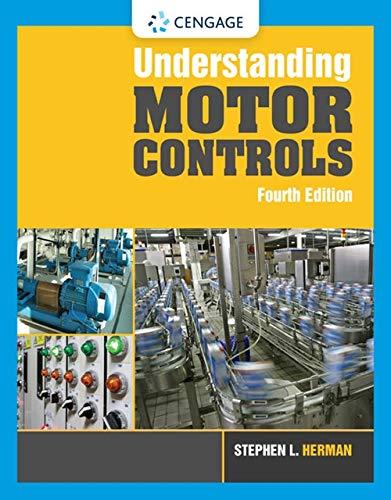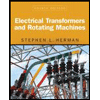
Concept explainers
Two basic types of transistor.
Explanation of Solution
Transistors are classified on the basis of the majority charge carriers present in the parts of the transistor. The three parts of transistor are emitter, collector and base. The base situated between collector and emitter. If the collector has majority charge carriers as electrons, base has holes and emitter has electrons as majority charge carriers then such a transistor is named as NPN transistor.
If the majority charge carriers in collector and emitter are holes and majority charge carriers in base are electrons, such a transistor is named as PNP transistor. According to the usage of P-type or N-type semiconductor in emitter, collector and base, transistor is classified as NPN or PNP transistors. Therefore, NPN transistors and PNP transistors are the two fundamental types of transistors.
Want to see more full solutions like this?
Chapter 48 Solutions
Understanding Motor Controls
- Problem 8.28 Part A 10 of 10 ■Review The uniform crate resting on the dolly has a mass of 530 kg and mass center at G as shown in (Figure 1). If the front casters contact a high step, and the coefficient of static friction between the crate and the dolly is μs = 0.45, determine the greatest force P that can be applied without causing motion of the crate. The dolly does not move. Express your answer to three significant figures and include the appropriate units. Figure -0.5 m- 0.6 m 0.3 m 0.1 m B 0.4 m 0.3 m > ☐ P = 1210 Submit о ΜΑ N Previous Answers Request Answer × Incorrect; Try Again 1 of 1 < Return to Assignment Provide Feedback ?arrow_forwardQ1: For the system shown in Fig. 6.7, the following data are applicable P1 = 7 bar Q=0.002 m3/sec Pipe: total length 15m and ID 38mm Oil: SG-0.90 and kinematic viscosity (v-0.0001 m2/s) Solve for P2 in units of bars. Motor OH Pump Breather P1 Pipe length = 3m 90' elbow ☐ 38 mm (ID) Pipe length = 2m P2 Load force Pipe length 4 m = Pipe length=6m 90' elbowarrow_forwardusing the three moment theorem please find the moments about B, C and Darrow_forward
- A viscous fluid flows in a 0.10-m-diameter pipe such that its velocity measured 0.010 m away from the pipe wall is 0.9 m/s. If the flow is laminar, determine (a) the centerline velocity and (b) the flowrate. (a) Vi (b) Q = i m/s × 103 m³/sarrow_forwardThis is an old exam review question please help.arrow_forwardThis is an old exam review problem. Please helparrow_forward
- This is an exam review problem please helparrow_forwardThis is an old exam review problem. Please helparrow_forward3. The volumetric flow rate of air through a duct transition of the type shown in Table 12-9b (rectangular with two parallel sides) is 2 m3/s. The duct before the transition issquare, with a height of 50 cm. The expansion ratio across the transition is 4 (i.e., theduct area after the transition is 4 times greater than the duct area before the transition).a) Determine the pressure loss (in Pa) across the transition if the exit from the duct isabrupt (i.e., the diverging angle of the transition is 180º).b) Determine the percentage reduction in pressure loss for a transition diverging angleof 20º compared to the one in part (a).c) The head HVAC engineer requires the pressure loss across the transition to bereduced to less than 50% of the pressure loss for an abrupt exit (i.e., the case in part(a)), and suggests a transition diverging angle of 45º. Will this new diverging angleachieve the required reduction in pressure loss? Justify your answer.d) For a transition diverging angle of 90º,…arrow_forward
- The wheel shown is made of 2 rings and 8 rods. The otter ring weighs 100 lbs, the inner ring weighs 15 lbs,and each of the rods weighs 20 lbs. Find the moment of inertia of the wheel about an axis that comes directlyout of the page through point A.arrow_forwardMini project You are an engineer working for a power systems company responsible for ensuring grid stability. Your team has recently observed low-frequency oscillations in the system following disturbances such as load changes, faults, and switching operations. These oscillations have led to voltage instability, frequency deviations, and, in severe cases, system blackouts. A task force has been formed to address this issue, and you have been assigned a critical role in developing a damping control strategy. Your objective is to analyze system performance, propose engineering solutions, and compare the effects of different damping approaches. Answer the following questions 1. Identify the Engineering Problem: - What is the fundamental issue affecting power grid stability? - How do low-frequency oscillations impact the system's reliability? - What parameters indicate system instability? 2. Assess the Current Status Using Equations and Calculations: - Given the characteristic roots of the…arrow_forwardH.W 4: The beam shown below is subjected to the distributed loading of w=120 kN/m. Determine the principal stresses in the beam at point P, which lies at the top of the web. Neglect the size of the fillets and stress concentrations at this point. I=67.4×10-6 m4. 15 mm w=120 kN/m B 0.3 m 2 200 mm A 10 rim 15 mm 175 mmarrow_forward
 Understanding Motor ControlsMechanical EngineeringISBN:9781337798686Author:Stephen L. HermanPublisher:Delmar Cengage Learning
Understanding Motor ControlsMechanical EngineeringISBN:9781337798686Author:Stephen L. HermanPublisher:Delmar Cengage Learning Electrical Transformers and Rotating MachinesMechanical EngineeringISBN:9781305494817Author:Stephen L. HermanPublisher:Cengage Learning
Electrical Transformers and Rotating MachinesMechanical EngineeringISBN:9781305494817Author:Stephen L. HermanPublisher:Cengage Learning Automotive Technology: A Systems Approach (MindTa...Mechanical EngineeringISBN:9781133612315Author:Jack Erjavec, Rob ThompsonPublisher:Cengage Learning
Automotive Technology: A Systems Approach (MindTa...Mechanical EngineeringISBN:9781133612315Author:Jack Erjavec, Rob ThompsonPublisher:Cengage Learning Refrigeration and Air Conditioning Technology (Mi...Mechanical EngineeringISBN:9781305578296Author:John Tomczyk, Eugene Silberstein, Bill Whitman, Bill JohnsonPublisher:Cengage Learning
Refrigeration and Air Conditioning Technology (Mi...Mechanical EngineeringISBN:9781305578296Author:John Tomczyk, Eugene Silberstein, Bill Whitman, Bill JohnsonPublisher:Cengage Learning



